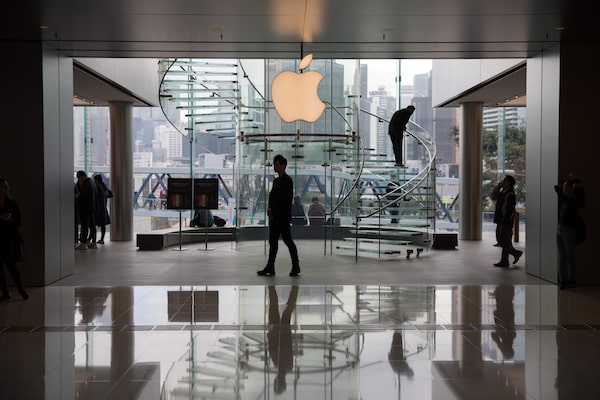
Shoppers walk past the Apple Inc. logo in Hong Kong earlier this month.JEROME FAVRE
Slowing iPhone sales and a weakening Chinese economy are taking a toll on Apple Inc. and increasing the tech giant’s reliance on its software and services for growth.
Apple said Tuesday that it suffered a rare decline in both sales and profit in the quarter that ended in December – the first time both metrics fell in the holiday quarter in more than a decade. Those developments were in line with a letter Apple chief executive Tim Cook sent to investors on Jan. 2 warning revenue would fall short of expectations. At the time, Mr. Cook pointed a finger directly at China’s economy and trade woes.
Threats to the company’s hardware growth, which had been driven primarily by the iPhone since it launched in 2007, have been mounting for years. But Tuesday’s results underlined Mr. Cook’s challenge to find growth elsewhere, including services, such as Apple Music, the App Store and Apple News. Revenue from its services segment grew 19 per cent in the quarter – the same rate as all non-iPhone growth – to US$10.1-billion, while its iPhone revenue declined 15 per cent, to US$52-billion.
“Our ecosystem is stronger than ever before,” Mr. Cook said in a conference call Tuesday, touting his plan to continue growing services revenue. “...It’s not in our DNA to just sit around and wait for macroeconomics to improve.”
Mr. Cook’s rare warning to investors earlier this month revised the company’s projected revenue for the first fiscal quarter of 2019 to US$84-billion, down from a range of US$89-billion to US$93-billion. Mr. Cook wrote that the slowdown of China’s once-rapidly growing economy and its trade tensions with the United States “accounts for all of our revenue shortfall to our guidance and for much more than our entire year-over-year revenue decline.”
Apple shares were up 4.6 per cent to US$163.55 in after-hours trading Tuesday evening. While its revenue of US$84.3-billion represented a year-over-year decline of 4.5 per cent, it was slightly above the company’s revised forecast from Jan. 2. Its total profit for the quarter, which ended Dec. 29, 2018, was US$20-billion, down slightly from US$20.1-billion a year earlier. That translated to an earnings-per-diluted-share of US$4.18, which the Cupertino, Calif., company called an all-time high, and beat the analyst consensus of US$4.17.
Consistent with its revised forecast, Apple revealed Tuesday that its revenue from Greater China fell 27 per cent year-over-year to US$13-billion.
“Weak macro conditions in some emerging markets [were] significantly more severe than we originally foresaw, especially in greater China,” Mr. Cook said. “Most of the shortfall relative to our original guidance, and over 100 per cent of our worldwide year-over-year decline was driven by our performance in Greater China.”
In an e-mail, D.A. Davidson analyst Tom Forte said “China remains a concern; especially, given the unresolved trade talks between the Chinese and US governments.” However, he pointed to the share price as a sign of “a relief rally that things are not as bad as some investors had feared.”
Mr. Cook also cited unfavourable foreign-exchange rates, less adoption of wireless-carrier subsidies and fewer iPhone upgrades as reasons for the revenue decline.
“We couldn’t be more proud of our [latest] iPhone lineup,” he said, but admitted customers have been clinging to their handsets longer – which external studies, including from Morgan Stanley, have already suggested. He cited the company’s popular battery-replacement program as one reason for consumers holding onto their phones.
For months, analysts have warned about flagging iPhone income – particularly since early November, when Apple said it would no longer disclose quarterly unit sales. With increasing price points on its latest models, such as the iPhone XS, some believed the company could balance fewer units sold with greater revenue per individual handset. But Apple’s reported iPhone revenue told a different story.
Responding to a question about rising iPhone prices, Mr. Cook said while prices remained in line in the United States, foreign-exchange rates ratcheted up the price in other countries, especially emerging markets.
 Josh O’Kane
Josh O’Kane